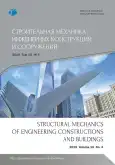The definition of the critical buckling load beam model and two-dimensional model of the round cylindrical shell that interact with the soil
- Authors: Kosytsyn S.B.1, Akulich V.Y.1
-
Affiliations:
- Russian University of Transport
- Issue: Vol 15, No 4 (2019)
- Pages: 291-298
- Section: Theory of thin elastic shells
- URL: https://journal-vniispk.ru/1815-5235/article/view/346281
- DOI: https://doi.org/10.22363/1815-5235-2019-15-4-291-298
- ID: 346281
Cite item
Full Text
Abstract
Aims of research. The research is aimed at determining the critical buckling load at which the shell interacting with the soil loses equilibrium stability, and finding the buckling mode of the shell in the linear and nonlinear formulations of the task. Methods. The task is solved by a numerical method using a finite element complex, which allows investigating the stress-strain state and assessing the equilibrium stability of beam models and two-dimensional models of the round cylindrical shell. Three design cases of the beam model and two design cases of the two-dimensional model interacting with the soil are compiled. There is a load summary acting on the shell. The calculations are carried out in linear and geometrically nonlinear formulations using a linear elastic model of the material. Contact elements of one-side and two-side action are used. Critical buckling load are determined relative to the actual load of its own weight. Results. Critical buckling load are determined and the buckling mode of the round cylindrical shell interacting with the soil are found. There is a comparative analysis of the results. An assessment of the stability margin of the shell relative to the actual load is given.
About the authors
Sergey B. Kosytsyn
Russian University of Transport
Author for correspondence.
Email: kositsyn-s@yandex.ru
SPIN-code: 9390-7610
Adviser of the RAACS, D.Sc. in Engineering, Professor of the Department of Theoretical Mechanics
15 Obraztsova St., Moscow, 127994, Russian FederationVladimir Yu. Akulich
Russian University of Transport
Email: kositsyn-s@yandex.ru
PhD student of the Department of Theoretical Mechanics
15 Obraztsova St., Moscow, 127994, Russian FederationReferences
- Rychkov S.P. (2004). MSC. Visual Nastran dlia Windows [MSC. Visual Nastran for Windows]. Moscow, NT Press, 552. (In Russ.)
- Gekkeler I.V. (1934). Statika uprugogo tela [Elastic body statics]. Moscow, Gostekhizdat Publ., 288. (In Russ.)
- Volmir A.S., Kuranov B.A., Turbaivskii A.T. (1989). Statika i dinamika slozhnykh struktur [Statics and dynamics of complex structures]. Moscow, Mashinostroenie Publ., 248. (In Russ.)
- Fesik S.P. (1982). Spravochnik po soprotivleniiu materialov [Handbook of structural resistance]. Kiev, Budivelnik Publ., 147. (In Russ.)
- Leontiev A.N., Leontieva I.G. (2010). Analysis of an infinite composite beam located on elastic foundation. Vestnik MGSU, (4), 167–172. (In Russ.)
- Gabbasov R.F., Uvarova N.B., Filatov V.V. (2012). On calculation of beams resting on two-parameter elastic foundations. Vestnik MGSU, (2), 25–29. (In Russ.)
- Kositsyn S.B., Dolotkazin D.B. (2004). Raschet sterzhnevykh sistem vzaimodeistvuiushchikh s uprugim osnovaniem metodom konechnykh elementov s ispolzovaniem programmnogo kompleksa MSC/Nastran for Windows [Calculation of beam systems interacting with an elastic foundation by finite element method using the software complex MSC/Nastran for Windows]. Moscow, MIIT Publ.,1. (In Russ.)
- Kositsyn S.B., Chan Suan Lin. (2014). Numerical analysis of the stress-strain state of orthogonally intersecting cylindrical shells with and without taking into account their one-sided interaction with the surrounding soil mass. International Journal for Computational Civil and Structural Engineering, (1), 72–78. (In Russ.)
- Kositsyn S.B., Chan Suan Lin. (2013). Comparative analysis of various models of the soil mass surrounding the cylindrical shell, taking into account the possibility of its detachment from the shell. International Journal for Computational Civil and Structural Engineering, (1), 65–72. (In Russ.)
- Timoshenko S.P. (1955). Ustoichivost uprugikh sistem [Theory of Elastic Stability]. Moscow, Gostekhizdat Publ., 92. (In Russ.)
- Timoshenko S.P. (1972). Kurs teorii uprugosti [A course in the theory of elasticity]. Kiev, Naukova dumka Publ., 567. (In Russ.)
- Semenov A.A. (2017). Methodology research of stability of shallow orthotropic shells of double curvature under dynamic loading. International Journal for Computational Civil and Structural Engineering, (2), 145–153. (In Russ.)
- Semenov A.A. (2016). Strength and Stability of Geometrically Nonlinear Orthotropic Shell Structures. ThinWalled Structures, 106, 428–436.
- Skopinskij V.N., Smetankin A.B., Vozhova N.V. (2011). Selection of schematized stress diagram for elasticplastic analysis of intersecting shells. Mechanical Engineering and Engineering Education, (1), 58–65. (In Russ.)
- Kositsyn S.B., Fedorov V.S., Akulich V.Yu. (2018). Geotechnical projection of the influence of the construction of the designed metropolitan tunnel by the method of shield passage on the sedimentation of the earth’s surface. Russian Journal of Building Construction and Architecture, 37(1), 81–91.
- Aleksandrov A.V., Potapov V.D. (1990). Osnovy teorii uprugosti i plastichnosti [Fundamental theory of elasticity and plasticity]. Moscow, Vysshaia shkola Publ., 1. (In Russ.)
- Shimkovich D.G. (2008). Femap & Nastran. Inzhenernyi analiz metodom konechnykh elementov [Femap & Nastran. Finite element engineering analysis]. Moscow, DMK Press, 701. (In Russ.)
- Zenkevich O.K. (1975). Metod konechnykh elementov v tekhnike [Finite Element Method in Engineering]. Moscow, Mir Publ., 542. (In Russ.)
Supplementary files









